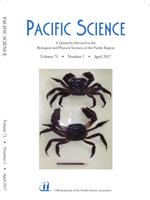Thirteen commonly consumed types of fish caught in the North Pacific and locally available in Hawai‘i were analyzed using gamma spectroscopy to measure Fukushima-derived and historic 134Cs and 137Cs isotopes. All fish samples had detectable 137Cs above 95% confidence intervals. Three out of the thirteen samples had 134Cs, an isotope indicative of Fukushima releases, detected above 95% confidence intervals. The highest 134Cs and 137Cs concentration in the examined species was in ‘ahi tuna, carrying 0.10 ± 0.04 Bq/kg and 0.62 ± 0.05 Bq/kg, respectively. Other samples with 134Cs activities found above their 2-sigma uncertainty were albacore tuna and swordfish. Historic and Fukushima-derived contributions were evaluated, and in several samples the Fukushima-derived radiocesium dominated the total radiocesium inventory with up to 61% contribution. All activities were below derived intervention limits of 1,200 Bq/kg, and the doses to humans from consuming the fish attributable to radiocesium were 0.02–0.2 µ Sv, in comparison to 6–20 µ Sv contributed by the natural 40K present in the same fish.
How to translate text using browser tools
1 April 2017
In the Wake of Fukushima: Radiocesium Inventories of Selected North Pacific Fish
Hannah R. Azouz,
Henrietta Dulai
ACCESS THE FULL ARTICLE

Pacific Science
Vol. 71 • No. 2
April 2017
Vol. 71 • No. 2
April 2017




